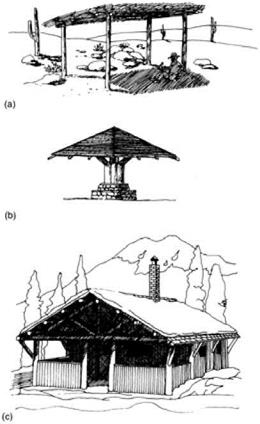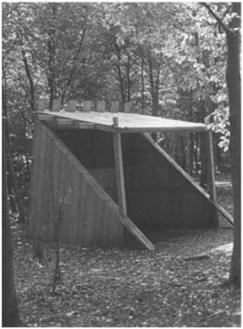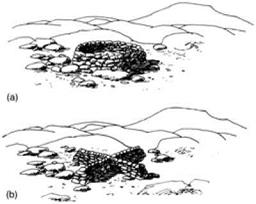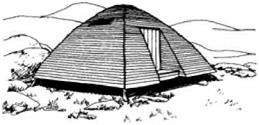Along the length of the trail it might be helpful to hikers for shelters to be located at appropriate locations to provide shelter from inclement weather, shade in hot conditions, or camping opportunities. They can vary from simple roofs to give rain and sun
|
An interesting small shelter along a trail, made in four prefabricated sections, which are fitted together on site. This offers shelter or shade depending on the weather. |
protection, to simple walls to give shelter from winds, or to completely enclosed structures to give refuge from the worst conditions, or camping places or safety retreats.
The simple roofed shelters might be similar to the picnic shelters described in Chapter 7, except that in remoter places they should be less finished in construction. A flat thatched roof of poles lashed together and covered in locally cut materials such as grass or twigs could provide shade in a desert climate. A monopitch frame of round timber notched together and roofed in shingles, split logs or planks will provide some shelter from rain and perhaps wind. The Lapp tent or other teepees, wigwams or wickiups modelled on indigenous or vernacular structures would work in appropriate places where more shelter is required.
In very exposed places such as mountain tops, where the wind is severe, hikers are at some risk of exposure when cooling off after the exertion of the climb. The windchill factor can be greatly reduced by erecting stone-walled shelters that enable climbers and hikers to sit in the lee of the wind to rest. Such shelters can be circular, creating a totally enclosed space out of any wind, or cross-shaped so that at any one time one quadrant will be entirely sheltered. Either of these types will work, but some skill is needed to build them well and tidily.
In severely exposed conditions, or in places where the weather can change suddenly with low temperatures, refuge shelters could be provided for climbers and hikers caught unawares in a storm or blizzard. If the trail is above the tree-line in the open, buildings can be difficult to erect and keep weatherproof, as well as being intrusive in these sensitive places. One option is to find a hollow or low cliff beneath which a lean-to shelter can be erected, built from stone with a roof and door made from stout timber. The location must be in a place that can be found easily, marked on maps and on site and signed from the trail so that it cannot be missed.
A second option is to use a prefabricated structure designed to be weatherproof, which is taken up to the site and anchored in place with cables or Rawlbolts of the type used to anchor climbing cables. Timber shelters of a ‘beehive’ shape have been developed for this purpose in Scotland, notorious for its changing weather and rapidly descending cloud, which reduces visibility extremely quickly. These shelters can accommodate several people, who can stay overnight if need be using the floor and benches provided to
 |
Some shelter ideas that look right for their respective landscapes: (a) A simple overhead shelter of poles and twigs gives overhead shade in a hot desert climate such as Arizona or New Mexico,
USA. (b) A shelter like a giant umbrella based on a 1930s CCC design. It is an all-wood construction set in a stonework base, which acts as a bench. (c) A shelter providing overnight accommodation in Kokanee Glacier Provincial Park, British Columbia, Canada.
|
Two designs for stone-built mountain summit shelters, which act as windbreaks whatever the weather. |
|
A specially designed beehive-shaped mountain shelter made of a curved timber pole framework covered and floored with sawn timber. Designed and built by Charles Gulland for Scottish Natural Heritage. |
sleep on.
Where the trail is in the tree-line of a mountain forest, a log cabin style of building can be constructed on site and provided with a fireplace, as there is fuel nearby. The cabin should be primitive, to maintain the wilderness qualities while providing refuge for hikers.
Any overnight shelter can become a squalid place if not looked after by the users or by ranger staff. If it is in a remote location it is unlikely that rangers will be able to visit it very frequently. It is helpful if all users follow a code of conduct for such places, cleaning out food remains, litter and ashes, refilling wood stores and being hygienic when attending to personal needs. The provision of a visitors’ book can help record incidents, weather conditions and observations about the state of the hut and the people using it.






